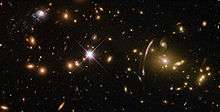Abell 2667
Abell 2667 is a galaxy cluster. It is one of the most luminous galaxy clusters in the X-ray waveband known at a redshift about 0.2.
| Abell 2667 | |
|---|---|
 Abell 2667 from Hubble Space Telescope. Comet Galaxy is top-left (blue). | |
| Observation data (Epoch J2000) | |
| Constellation(s) | Sculptor |
| Right ascension | 23h 51m 42s[1] |
| Declination | −26° 00′ 00″[1] |
| Richness class | 3[2] |
| Bautz–Morgan classification | I [2] |
| Redshift | 0.23000[3] |
| Distance (co-moving) | 927 Mpc (3,023 Mly) h−1 0.705 [3] |
This cluster is also a well-known gravitational lens.
On 2 March 2007, a team of astronomers reported the detection of the Comet Galaxy in this cluster. [4] This galaxy is being ripped apart by the cluster's gravitational field and harsh environment. The finding sheds light on the mysterious process by which gas-rich spiral-shaped galaxies might evolve into gas-poor irregular- or elliptical-shaped galaxies over billions of years.
References
- "HEASARC Browse". Result for Abell 2667. Retrieved 2010-10-03.
- Abell, George O.; Corwin, Harold G., Jr.; Olowin, Ronald P. (May 1989). "A catalog of rich clusters of galaxies" (PDF). Astrophysical Journal Supplement Series. 70 (May 1989): 1–138. Bibcode:1989ApJS...70....1A. doi:10.1086/191333. ISSN 0067-0049. Retrieved March 13, 2012.
- "NED results for object ABELL 2667". NASA/IPAC Extragalactic Database (NED). Retrieved March 17, 2012.
- Cortese, L; Marcillac, D; Richard, J; Bravo-Alfaro, H; Kneib, J. -P; Rieke, G; Covone, G; Egami, E; Rigby, J; Czoske, O; Davies, J (2007). "The strong transformation of spiral galaxies infalling into massive clusters at z ~ 0.2". Monthly Notices of the Royal Astronomical Society. 376 (1): 157–172. arXiv:astro-ph/0703012. Bibcode:2007MNRAS.376..157C. doi:10.1111/j.1365-2966.2006.11369.x.
External links
- Hubble Space Telescope
- Spitzer Space Telescope
- NASA Astronomy Picture of the Day: Illusion and Evolution in Galaxy Cluster Abell 2667 (5 March 2007)
- ESA news
This article is issued from Wikipedia. The text is licensed under Creative Commons - Attribution - Sharealike. Additional terms may apply for the media files.